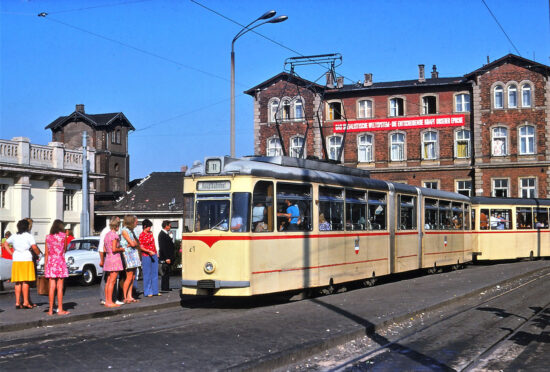Our German stay in “Around the World in Trams” continues during October and this time we go back in time and across to East Germany for another excellent selection of evocative photos taken in 1975 by Donald Brooks.
Donald Brooks explains more about the background:
Because private car ownership in the DDR (Deutsche Demokratische Republik/German Democratic Republic/East Germany) was very low in 1975, public transport had to be good to compensate. And generally speaking it was, if not necessarily particularly fast, modern or frequent. For the tram enthusiast the large number of systems across the country included many in medium-sized or small towns, places which elsewhere might have closed their tramways decades earlier – if indeed they had ever had one in the first place.
In the 1970s there were still many four-wheeled trams in operation, although these tended to have been quite recently built or rebuilt following the devastation of the Second World War. German-built trams appeared more regularly on the smaller systems, with Tatra fleets more apparent in the larger cities. Fares were minimal and were usually paid by inserting coins into a fare box and tearing off a ticket.
We start off this selection in Rostock. Although Schwerin is the capital of the north-eastern Land of Mecklenburg-Vorpommern, Rostock is its largest city with a population of roughly 211,000 today, about 12,000 fewer than in the 1970s. It lies on the River Warnow, just inland of the Baltic Sea. There has been a settlement on the site since the 11th century and the city became a member of the Hanseatic League in the mid-13th century. Its port is at Warnemünde, about 13kms to the north, served by an S-Bahn service which the DR operated every ten to fifteen minutes in the 1970s.
The standard gauge tramway opened in 1881 with horse-drawn cars, conversion to electric operation following in 1904. There are six routes today on a network totalling 35.5kms, with major extensions and reroutings since the 1990s. The fleet, currently operated by Rostocker Strassenbahn AG, is now predominantly low-floor, as would be expected.
In the 1970s route 11, along with 4 and 12, terminated in a loop outside the Hauptbahnhof, providing connections from the station to most parts of the city then served by tram. The main station or Hauptbahnhof was at the southern end of Rostock and the number 11 terminated at Neuer Friedhof (New Cemetery), reached by a circuitous route.
In the below picture, articulated car 21 and a trailer are seen arriving at the Hauptbahnhof, with a colourful queue of passengers waiting in the sunshine to board for the return journey. 21 was built by VEB Waggonbau Gotha in the 1960s and is basically two of their standard four-wheel trams linked by the articulated section. There were two almost identical types of this tram, G4-61 and G4-65, with the 61 and 65 denoting the first year of manufacture. Rostock employed the type as late as 1996, when its car 730 was the last G4-61 in service. The slogan on the building in the background reads ‘The socialist world system – The decisive force of our era.’ In the event, things turned out otherwise.

